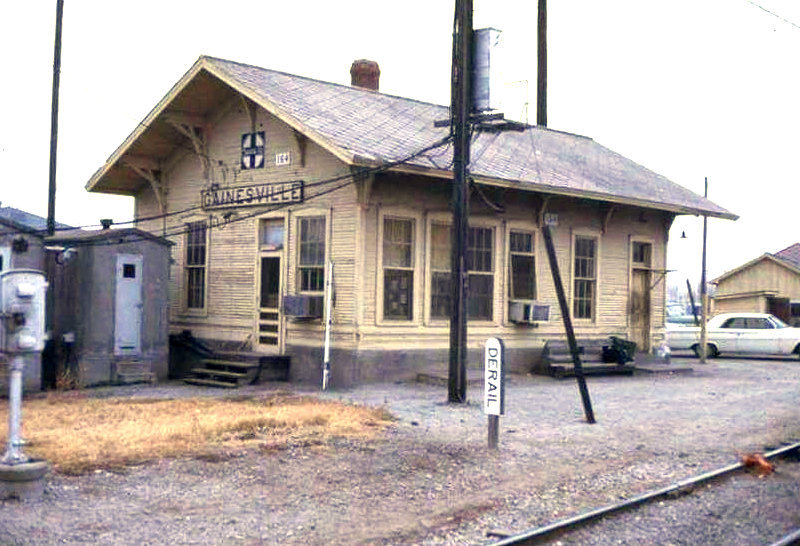
Texas Railroad History - Tower 164 - Gainesville
A Crossing of the Missouri - Kansas - Texas Railroad and the Gulf, Colorado & Santa Fe Railway
 |
Left: This undated photo provided by Karen Seay shows the Gulf, Colorado & Santa Fe (GC&SF) Railway Yardmaster's Office at Gainesville with "164" posted in two places on the building. The Tower 164 interlocker was a 21-function electrical plant authorized by the Railroad Commission of Texas (RCT) on April 20, 1931 where the GC&SF crossed the Missouri - Kansas - Texas (MKT, "Katy") Railroad (known prior to 1923 as the Missouri, Kansas & Texas Railroad, MK&T.) Electrical plants were often housed at a depot or yard office near the crossing such as this building, which was located within the acute angled northwest quadrant of the crossing diamond. The controls would be accessible inside by designated operators; for Tower 164, Santa Fe was responsible for interlocker operations and maintenance (O&M.) Because the crossing existed prior to 1901, the capital outlay for the plant and its associated trackside signals would have been shared equally between the two railroads. The recurring O&M expenses for the interlocker would have been split on a "weighted function" basis, i.e. the ratio of the interlocker functions assigned to each railroad compared to the total function count (in this case, 21, although this could change over time as modifications were made to add or eliminate tracks, switches and signals.) At the left edge of the image, the metal box mounted on the post attached to the concrete pedestal contained the manual controls used by train crewmembers (typically Katy crews) to change the signals during times when the building was not staffed. A 1963 RCT document preserved at DeGolyer Library, Southern Methodist University, mentions 24-hr interlocker control at Gainesville by "an operator in the interlocking tower." The "interlocking tower" was simply the Yardmaster's Office, hence the white "164" placards were necessary to comply with RCT rules for physical identification of interlockers. |
The Gainesville area was settled long before the railroads arrived. The town
was organized in 1850, named for US Army General Edmund Gaines, but it was not
officially incorporated until 1873. Forty miles east
of Gainesville, in 1872, the Red River was bridged from Oklahoma into the new
town of
Denison by the Katy railroad. When the Houston & Texas Central main line from the south was completed into
Denison in 1873, it provided a route to Houston and
Galveston which fostered significant commercial
growth at Denison. This motivated investors to build rail lines in various
directions out of Denison to connect freight and passengers with both railroads. One of these was the Denison & Pacific (D&P) Railroad which
built 42 miles from Denison to Gainesville in 1878-79. The first D&P train
reached Gainesville on November 7, 1879, but shortly thereafter, the enterprise
ceased operations, presumably due to a lack of money to run the railroad. On
March 11, 1880, the D&P was sold to the Denison & Southeastern Railway, which
was building a line from Denison to Greenville. Two weeks later, the D&S changed
its name to the Missouri, Kansas & Texas Extension Railway, part of a plan to
lure the Katy into acquiring the newly combined railroads, which it did in November,
1881. This gave the Katy two lines out of Denison: southeast to
Greenville and
west to Gainesville.
The Katy remained the only rail line into
Gainesville until December 29, 1886 when the GC&SF arrived in town. This construction was part of the GC&SF's agreement with the Atchison, Topeka and Santa Fe
Railway wherein the GC&SF would complete three specific construction projects
within a year and then be acquired by Santa Fe on favorable terms. One of the
required projects was to build from Fort Worth to
Purcell, Oklahoma; Santa Fe construction forces were building toward Purcell
from the north and the railroads would connect there. The line was completed
as planned and the GC&SF became a subsidiary of Santa Fe.
Prior to
Santa Fe's arrival in Gainesville, local investors chartered the Gainesville, Henrietta and
Western (GH&W) Railway in July, 1886 to build west from Gainesville to
Henrietta. This
70-mile construction was completed in 1887 and the line was promptly sold to the
Katy, giving the Katy a complete route from Denison to Henrietta via Gainesville.
The Katy eventually
extended the tracks from Henrietta northwest to Wichita Falls and beyond.
Locomotives for GH&W construction trains would have been brought to Gainesville
from Denison via the Katy, hence the Katy and GH&W tracks were connected at
Gainesville in the early stages of construction, almost certainly before the
GC&SF arrived in Gainesville at the end of 1886. Thus, the Katy tracks were most
likely in place, and it was Santa Fe that installed the crossing diamond as they
built north toward Oklahoma.
Although the
Katy's route through Gainesville was generally east / west, the tracks through
the middle of town were on a north / south bearing because the Katy's line east to Denison was south
of downtown while their line west to Henrietta was north of downtown. When Santa
Fe built northward through Gainesville, they mostly paralleled the existing Katy
right-of-way (ROW) for a mile through the middle of town, staying west of the
Katy tracks. The Katy and Santa Fe parallel lines evolved into multiple tracks
and industry spurs, and eventually, Santa Fe built a yard on the north side of
downtown (identified as "North Yard") near where the Katy line curved northwest
across the Santa Fe. The presence of the Santa Fe yard no doubt inhibited
train speeds, so the need to stop at the uncontrolled crossing may not have been
a significant issue. It is also possible that the crossing's proximity to the
Santa Fe yards resulted in special "yard limits" rules governing the junction.
For whatever reason, the need for an interlocker at Gainesville was deferred
until 1931, thirty years after RCT began approving interlocker installations in
Texas.
In 1970, the Katy abandoned 99 miles of track between Whitesboro and
Henrietta, which included the tracks through Gainesville. In 1995, Santa Fe
merged with Burlington Northern to create Burlington Northern Santa Fe (BNSF).
BNSF now owns and operates all remaining tracks and railroad facilities at
Gainesville.
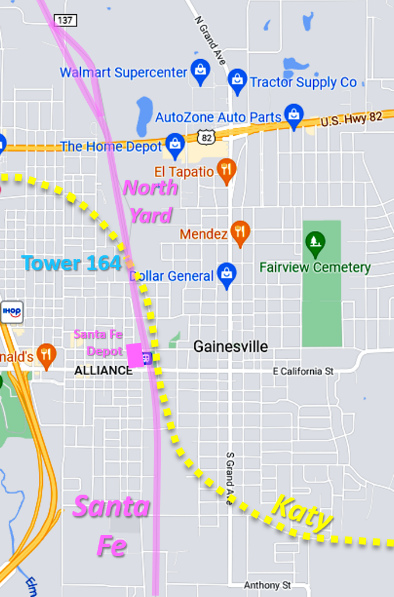
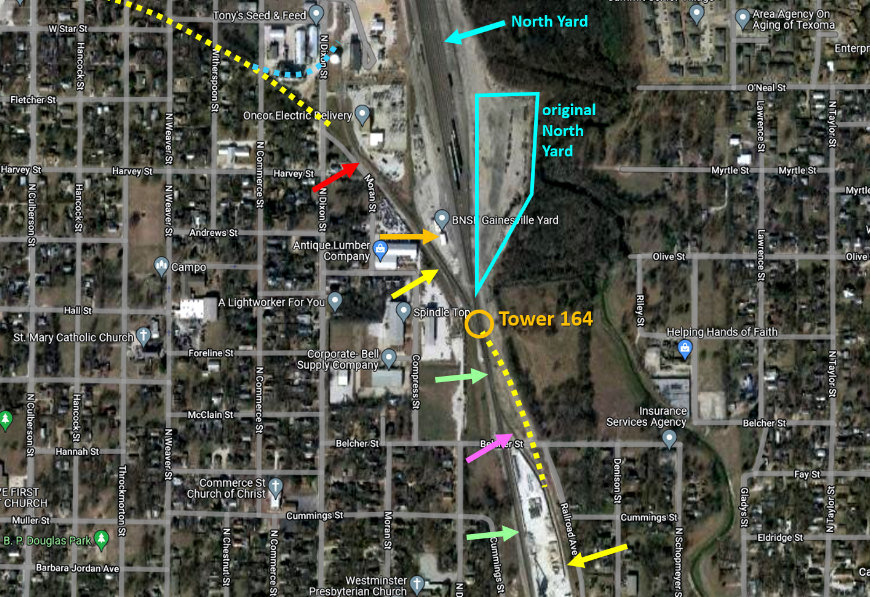
Above Left:
overview Google Map of the historic rail lines through Gainesville
Above Right: This annotated
Google Earth satellite view shows where BNSF has retained two short segments
(yellow arrows) of the Katy main line to facilitate service to two businesses.
(How much of the Katy main was initially retained after its abandonment in 1970 is undetermined.)
The southeast segment along Railroad Avenue reaches a scrap yard immediately
south of Scott St., just off the bottom of the image. To reach this segment, an
exchange track dating back to at least 1915 (pink arrow) near the BNSF
main (green arrows) was retained, and the Katy main (yellow dashes) was scrapped. The surviving Katy main northwest of the crossing, along Moran St., has a switch (red arrow)
to serve what is now the Red River Farm Co-op. In the steam era, this area was
the site of Katy's coal storage. It was also reached off the Katy
main by another spur (blue dashes) that crossed Dixon
St., where rails remain in the pavement. North Yard now extends (off the top of
the map) to a distance of approximately one mile north from the former Tower 164
crossing (orange circle), but the original yard (blue outline) was directly adjacent to
the crossing. The interlocker
controls were at the Yardmaster's Office, northwest of the crossing (orange
arrow.) Below
Left: Along Moran St., the original Katy ROW continued to the
left where the railroad ties are stacked. A permanently-switched spur to the Red
River Farm Co-op curves off to the right. The four gray silos to the left were
also served by the Katy spur that came off the main and ran behind them (in this
view),
continuing across Dixon St. (below right)
where rails are still visible. (Google Street Views, Aug. 2013 and July 2022)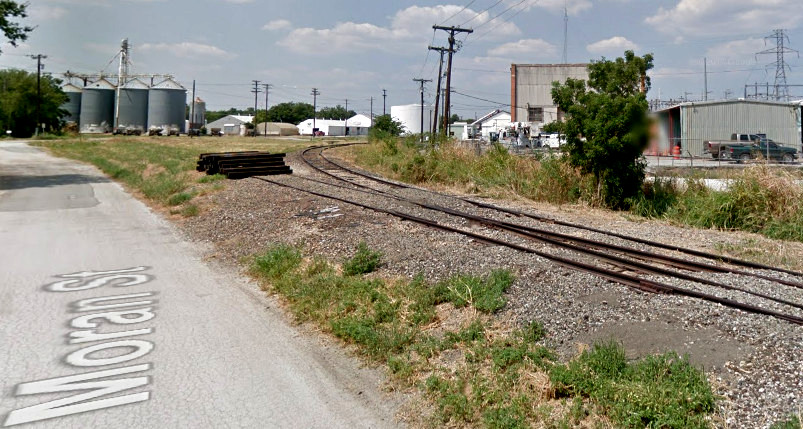
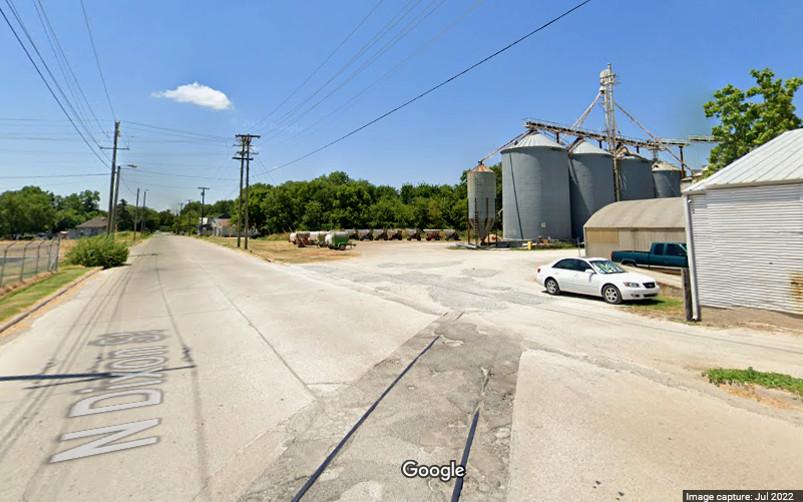
 |
Left:
This track chart from the Katy's Office of the Chief
Engineer (courtesy Ed Chambers) shows the track configuration at
Gainesville in 1915. The connecting track near the Katy's water tank is
the pink arrow on the annotated satellite view above. Below:
A derail is visible in this view southeast down the Katy ROW at the
former Tower 164 crossing. The Katy main crossed here and turned south,
passing in front of the while buildings in the distance. (Myron Malone
photo,
c.2004)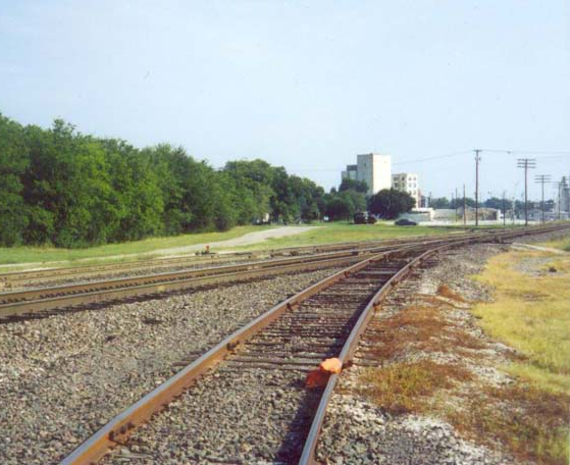 |
Below: A southbound Santa Fe Texas Chief passenger
train sits at Santa Fe's Gainesville passenger depot in June, 1953 on its way from Chicago to
Galveston. Near the horizon on the left edge of the photo, a string of railcars
can be seen on the Katy tracks. The Tower 164 crossing was just off the left
edge of the photo. The building directly across the Santa Fe tracks from the
passenger depot is part of the Katy freight depot. The Katy tracks were on the
opposite side of the freight depot, and the Katy passenger depot was a couple of
dozen yards south of the freight depot. Also, note that the multistory white
buildings visible in Myron Malone's photo above are also visible in the photo
below, albeit from a different location and angle. (photo from the Burt Blanton
Collection, Museum of the American Railroad)
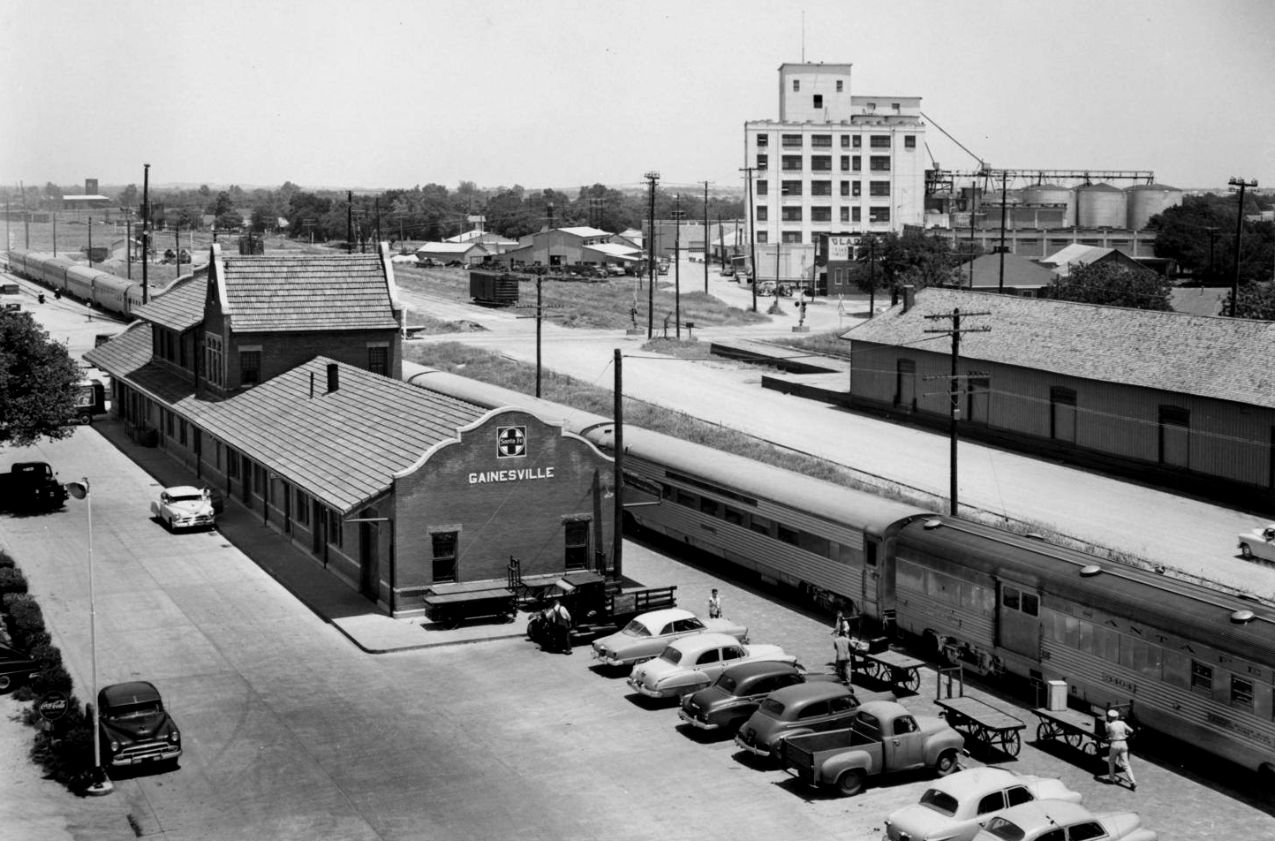
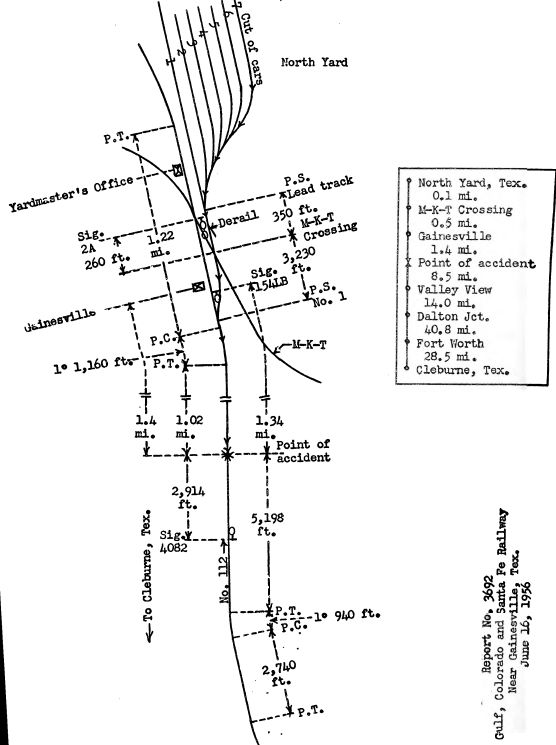 |
Left:
This track diagram for the vicinity of Tower 164 appears in an Accident
Investigation Report issued by the Interstate Commerce Commission (ICC)
dated July 25, 1956. The accident had occurred June 16, 1956 when "...there was a collision between a passenger train and a cut of
cars on the Gulf, Colorado & Santa Fe Railway..." which resulted
in injuries to three persons. The train was #112, northbound out of Fort
Worth. The diagram shows that the Yardmaster's Office was located within the northwest acute angle of the
crossing. This passage in the report describes the interlocker: The accident occurred at 11:55 pm, 1.4 miles south of the Santa Fe passenger depot. As shown on the diagram, the cut of cars came from track 7 north of the Tower 164 crossing. The cut began with 42 cars, but 22 were detached and moved to other tracks. "After the cars were detached, a yard brakeman applied the hand brake on the car at the north end of the 20 cars which remained on track No. 7. About 20 minutes later the yard crew shunted two loaded cars against the north end of the 20 cars. ... Apparently the 20 cars later started to move on the descending grade as a result of slack action. The two cars which were shunted against them did not couple with them. These cars remained at the north end of track No. 7, and the members of the yard crew were not aware that the 20 cars had move out of track No. 7 until they were so informed by the yardmaster." The cars rolled two miles south! 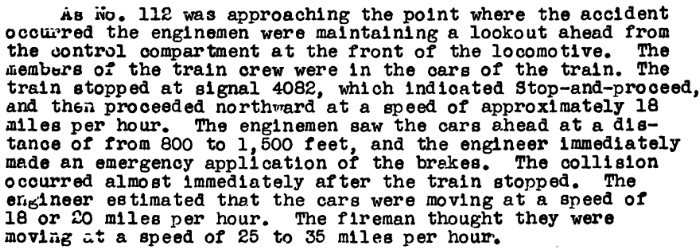 Read the 8-page report here. |


Above Left: Katy passenger depot at Gainesville, 1945 (H
D Connor Collection) Above Right:
Katy freight depot at Gainesville, 1965 (H D Connor Collection)
Below: The Santa Fe passenger
depot at Gainesville has been preserved and is in use as the local Amtrak
station. (Google Street View, July 2022)
